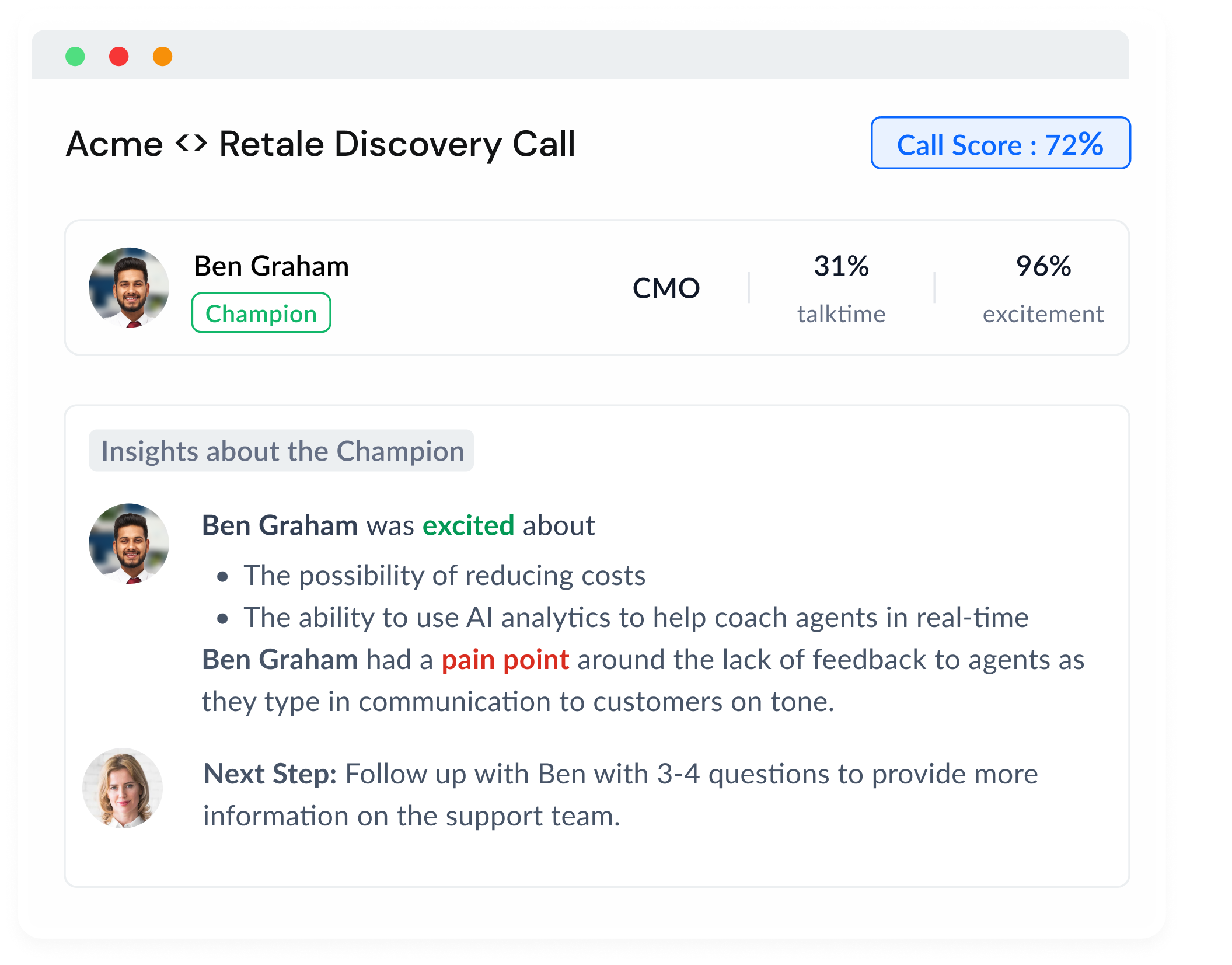I'll be sharing my findings on how sales can better align with marketing on content creation in this webinar on August 30th. Do join!
I've talked to 100+ sales and marketing leaders in the last few months, and aligning sales and marketing teams has been one of the top issues, if not the top issue, that they are concerned about.
I'm talking Chief Revenue Officers, VP Sales, CMOs, all the way to demand-gen and product marketers, as well as account executives and sales enablement.
These conversations have also helped me figure out why this is such a big deal, what organizations are doing about it, and what the most successful organizations have already done to tackle it. Part of our effort at Sybill has been to fix this issue, by using buyer behavior tracking to equip not just sales teams, but also marketing teams with critical insights to boost top-line revenue.
This is a culmination of the learnings from these conversations. In this article, I go over why this misalignment is an issue, and a 5-step way to fix it.

"Our sales and marketing teams work in isolation despite having similar goals.""The marketing collateral doesn't really answer the questions that I actually get in sales conversations."
Sales and marketing operating in silos, and not being aligned on goals, incentives, or projects, is a surefire recipe for leaving money on the table.
While sales and marketing alignment is a buzz-phrase right now to create communities, products, and content around, people define it differently in different contexts. In addition, a lot of the content on this golden alignment issue is pretty high-level and barely helps leaders figure out actionable ways to identify what a lack of alignment is costing them, and how they can take specific steps to fix it.
So let's dive straight into it.
What is sales and marketing alignment?
The alignment of your sales and marketing teams is the cumulation of strategy, goals, and decision-making across both functions.
Simply put, if your sales and marketing teams are not aligned, it looks like this: sales doesn't trust the leads coming in from marketing, MQLs are just numbers to be hit and may not bear great resemblance to qualified opportunities, sales teams don't use marketing content as much as marketing thinks they should, and marketing doesn't incorporate feedback (if any) from sales into their messaging and content creation as much as sales thinks they should, among other things.
While this sounds like a mess, many companies can still operate with this mess. The opportunity cost of not having proper alignment is huge, especially when the function of marketing is not just to create brand awareness, but also to generate leads, and create sales messaging and enablement content, which is the case in most B2B companies today.
The ROI of this alignment can be anywhere close to twice your revenue.
How sales and marketing alignment boosts sales outcomes and revenue
1. Shorter sales cycles
The alignment ensures that marketing becomes an essential component of the sales cycle.
- Marketing can retarget warm leads and the opportunities that are already in the early stages of the sales cycle, to remain top of mind for the buyers in those accounts. This can significantly reduce sales cycles.
- The best guess for ideal customers of a specific product typically comes from identifying patterns in closed/won deals. Marketing can create ideal customer profiles (ICPs) by closely collaborating with sales teams to understand the types of companies that tend to find the most value in the product. Thus, they can fill the sales pipeline with leads more likely to buy and move faster through the sales cycle, and by leveraging account-based marketing strategies.
- There is continuous and, more importantly, holistic lead qualification. If a buyer seems excited on a call, but hasn't downloaded any marketing material or attended a relevant webinar, it might signal a priority issue, for example. Coordinated efforts in prospect engagement, nurturing, and segmentation can significantly shorten the time it takes to close deals.
2. Reduced ramp time of sales reps
Marketers research customer pain points and run experiments in their ad/social/event campaigns. This knowledge might seep into sales enablement material, but often remains untapped outside of marketing collateral and conversations. Sales teams tend to discover much of this knowledge with their own conversations with prospects, doubling the effort around buyer understanding.
If the sales team uses this information, they can ensure more engaging sales calls with a better understanding of their customer cohorts right from day one. In other words, open collaboration and conversations between the two business units can reduce the ramp time of new sales reps significantly.
3. Delightful and consistent buying experiences
Similarly, prospects often raise objections and ask questions during sales presentations and demos. When there is a free flow of this information to marketing, they can design messaging and collaterals that answer these questions from the get-go.
For example, when marketing knows the crucial questions prospects ask in sales calls or the subsequent discussions, they have real-world inspiration to build new marketing content or to run campaigns to build a certain image in the eyes of their prospective customers. If, for example, parts of the demo or presentation continuously need more clarification during the sales process, it’s probably time for marketing to step up and proactively address these questions with blog posts, FAQs, or a customer story.
Sales and marketing alignment ensures that every prospect has a consistent buying experience, from when they download your marketing collateral to the day they sign the contract.
4. Sales and marketing alignment saves everyone’s time
How often do you hear of marketers spending weeks on creating that beautifully designed, incredibly insightful e-book that nobody downloaded? Or, for that matter, sales teams doing demos that go nowhere because the deck and the messaging didn’t resonate with the buyer?
When sales and marketing teams are on the same page, they ensure that their deliverables are backed by insights from the battlefront. Marketers are better aware of sales conversations, questions, and objections to drive their content strategy. And sales gets the precise messaging and collaterals it needs to close more deals.
Sales and marketing are like two players in a relay race. They must work in tandem and pass on the baton to each other to win customers and exceed revenue targets. But there’s a slight difference. Sales and marketing alignment also means that once the baton has been passed, it’s not the end of your part of the deal.
How to align sales and marketing
Meeting these aspirational collaboration and ROI targets is easier said than done. It is not just about aligning the people in the teams. Companies need to start working towards aligning processes, technologies, workflows, and more.
But there are roadblocks in this process, some out of resistance to change and some due to fragmented systems and data. In fact, businesses cite the following reasons for not being able to bring sales and marketing to the same page -
- Lack of accurate data on prospects and customers;
- Poor communication between teams;
- Fragmented prospect data across multiple systems.
To address these, businesses must focus on a 4-step approach that positions the sales and marketing team to communicate more effectively towards shared goals.

1. Start at the top
The process of sales and marketing alignment must start at the top – with involvement from sales and marketing leaders (and the CEO). This should be easy on paper – after all, a staggering 85% of these leaders believe collaboration and coordination between sales and marketing teams can lead to enhanced revenue outcomes.
So, what stops them from leading this initiative from the front? It’s just not a priority amidst overflowing email inboxes, meetings, increased responsibilities, goals, and tasks. But there is one more challenge. There is no go-to playbook for sales and marketing alignment; teams often don’t know where to start.
But the process of sales and marketing alignment has to begin somewhere. And the CXO office making it a strategic priority is crucial to achieving it. When the CEO wants the two to be aligned, and for it to be a system, rather than a one-off alignment meeting, the right processes and tools are put in place to make it happen.
2. Educate teams on how sales and marketing are symbiotic
Before your sales and marketing teams become open to the idea of closer collaboration, they will need to understand the dependencies between them and how one can achieve their individual goals with a little help from the other.
Marketing educates and influences potential buyers, qualifies leads, and consistently engages existing and potential customers with content and campaigns. Marketing brings deep insights into prospects, including information like what content they have engaged with before and what that says about their pressing needs.
On the other hand, sales can empower marketing by bringing insights from real-world use cases of their products and services, customer pain points and personas on the battlefront, market dynamics, customer health, and more.
3. Two teams, one goal = revenue
Sales and marketing teams must share (at least some) goals and KPIs. For example, it doesn’t matter how many times a marketing collateral was downloaded if it's not a direct influence on the readiness or qualification of the prospect downloading it. It also doesn’t matter how many call recordings sales teams shared with marketing if the latter can't get actionable insights from them. The contribution of sales and marketing must be both shared and measurable.
Sometimes, having a Chief Revenue Officer that oversees both the functions can handle this. She is responsible for revenue - be it by optimizing sales, marketing or customer success. In many ways, this role makes it clear, even in leadership positions, that the goal of both functions is revenue, and they just can’t afford to operate in silos.
In addition, with RevOps extending to tracking and measuring essential shared metrics throughout the funnel (from lead generation to deal closing), businesses can track the overall progress and performance of this revenue org.

An example of a shared KPI is lead scoring, though that's talked about quite a bit - shared ways of measuring lead quality ensures that marketing leads fit into the mold of the ones that the sales team expects and is prepared to take through the sales process.
Another example is the sales call engagement of buyers, especially in presentations and demos. If the feature messaging, competitive battlecards, and product differentiation messaging are aligned with what sellers tackle on a daily basis when talking to prospects, the engagement of buyers on sales calls keeps climbing up and leads to a smoother and faster sales process with higher win rates.
4. Build and agree on standard collaboration processes
A successful buying journey requires timely campaign planning, content inputs, and sales messaging in the moments that matter. These content inputs could be anything from competitive battle cards to customer stories, value statements, and explainer visuals. These assets need inputs from both sales and marketing.
The marketing team tracks the performance of marketing efforts. The sales team has a better handle on the messaging and positioning that resonate best during the deal process. Both teams must contribute to content planning by tapping into customer conversations and feedback.
With tools like Sybill, it becomes easier to understand, share, and collaborate on which messaging and collaterals resonate with prospects through conversational and behavior intelligence. Now, both teams have seamless access to the insights they need to perform better in their tasks.
5. Use technology to bring teams together
No, we don’t mean that shared Slack channel where the notifications pile up. A better way to do this is to simplify the insight-sharing process. For example, sales teams that use Sybill or other call recording tools efficiently share call highlights, customer pain points and objections, and pricing discussions. This helps the marketing team bridge these gaps early in the sales process.
Insights from sales calls can (and should, if you ask me) inform all content decisions - blog posts, educational videos, e-books - even if these assets have nothing to do with sales conversations. I cannot overstate the importance of sales feedback influencing lead generation and content strategies throughout the funnel.
This is where buyer behavior tracking comes into the picture. An example: Sybill's Deck page captures how much every single slide engages and excites your buyers on sales calls.
This ensures that marketing teams have better insight into how each collateral performs based on verbal and nonverbal cues during sales calls. Further, it empowers the marketing team to create messaging, campaigns, collaterals, and content designed to resonate with real-world customers.
Embrace sales and marketing alignment with Behavior Intelligence
Sybill quantifies buyer behaviors during sales calls, including body language, facial expressions, gaze, and the words, topics, and sentiments used, which helps it compute metrics like excitement and map them to the relevant piece of content.
Sybill can support your alignment efforts by calling out key customer insights related to messaging. You can track how much each slide or any other visual is being used across calls, and even track keywords, phrases, and topics across calls to observe the consistency of usage.
Further, you can track the average engagement and excitement generated by each piece of marketing collateral shared during sales calls, as well as the questions asked (and those that remain unanswered by the collateral) when each collateral is presented.
At Sybill, we also offer a custom GTM Intelligence Report specifically designed for sales and marketing alignment - surfacing trends in how much the marketing messaging resonates with various prospects and buyer personas in actual sales conversations. This helps surface content gaps, and for some orgs, it has even helped them shape their content strategy by shining light on the messages that seem to light up the buyers in specific markets and drive them towards a positive outcome.
You can do a content-comparison analysis, persona-comparison across industries and buyer authority, as well as seller-comparison while presenting each piece of content across the relevant set of calls.
This data forms the backbone of aligning your sales and marketing, the ultimate power couple!
I'll be talking in depth about how sales calls can help marketers identify content gaps and generate ideas for content that converts prospects into customers in this webinar. It's on August 30th, and hosted by our friends at BeaconsPoint, so please be there if you're interested!















.png)





